How to Draw Spider-Man
I’m thrilled to share my expertise on how to draw Spider-Man, presenting him in a playful chibi style. This guide is crafted with simplicity in mind, aiming to make each step from sketch to full-color as effortless as web-slinging through the city. With just a few strokes, you’ll be on your way to mastering the friendly neighborhood Spider-Man.
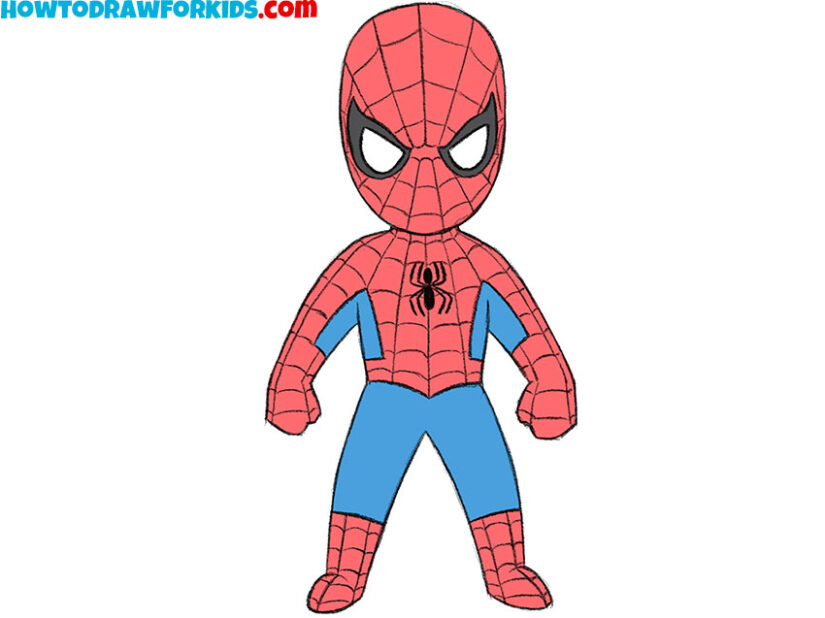
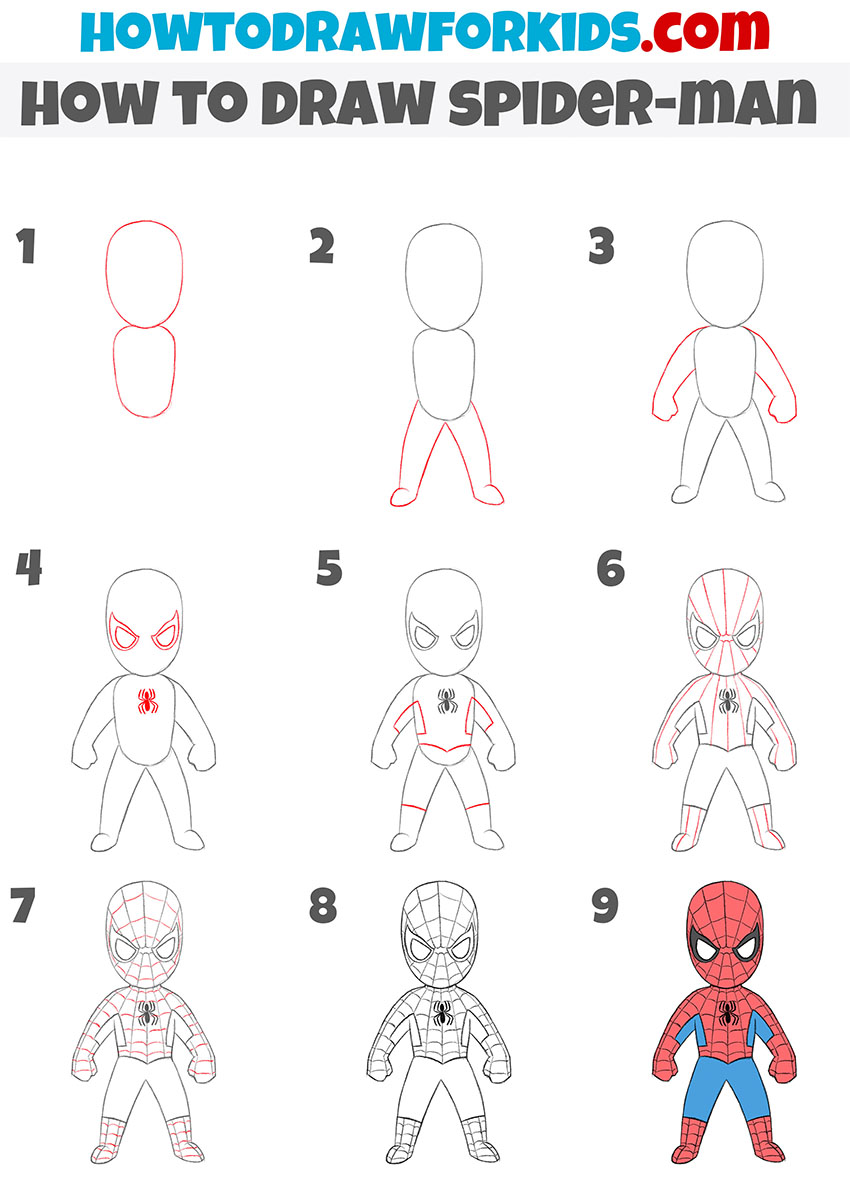
How to Draw Spider-Man: Basic Information
Get ready to channel your inner superhero with my drawing guide, crafted to help you masterfully draw Spider-Man in an adorable chibi style. This lesson is structured to transform complex superhero details into a friendly, more whimsical form that everyone can enjoy. We’ll explore proportion, expression, and iconic costume elements step by step.
Delving into this tutorial, you’ll learn to imbue your drawing with the essence of Spidey’s character – from his large, expressive eyes to the stylized webbing that adorns his costume. My approach breaks down each element, turning the daunting task of drawing a beloved character into a delightful experience.
By the conclusion of our artistic journey, to draw Spider-Man will feel like a new superpower you’ve acquired. This easy-to-follow guide is here to inspire confidence and creativity, paving the way for you to illustrate your favorite heroes with just a dash of whimsy and a whole lot of heart. So let’s create a miniature marvel together!
Spider-Man Drawing Tutorial
Materials
- Pencil
- Paper
- Eraser
- Coloring supplies
Time needed: 30 minutes
How to Draw Spider-Man
- Draw the head and body.
Start by drawing an oval shape for the head, followed by a smaller, rounded rectangular shape beneath it for the torso. This establishes the basic proportion and framework of the character’s upper body.

- Depict the legs.
Sketch two lines extending downward from the torso for the legs, ensuring they are of equal length. Mark a gentle taper towards the bottom, as in my example.
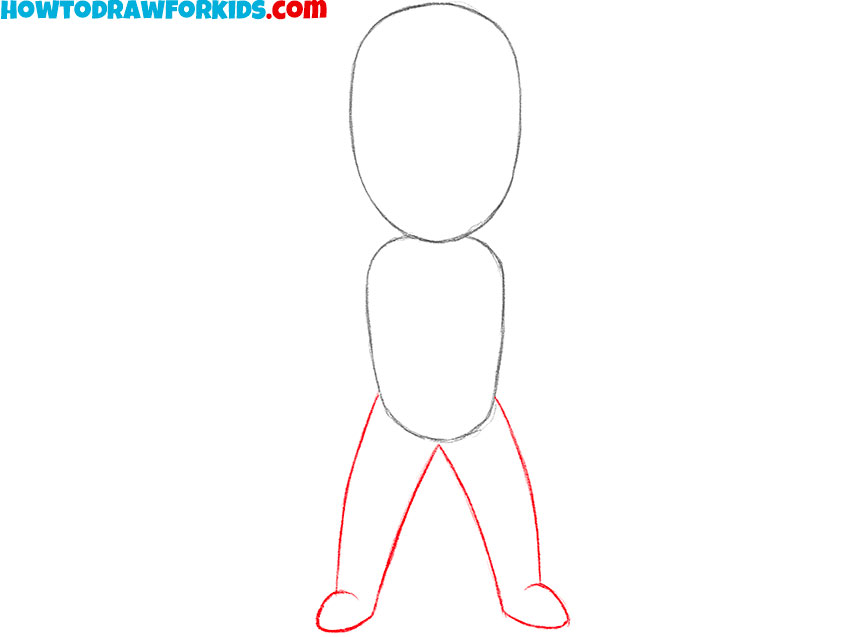
- Sketch out Spider-Man’s arms.
Widely spaced arms and clenched fists will create the effect of a decisive pose of a hero who is ready to rush into battle.
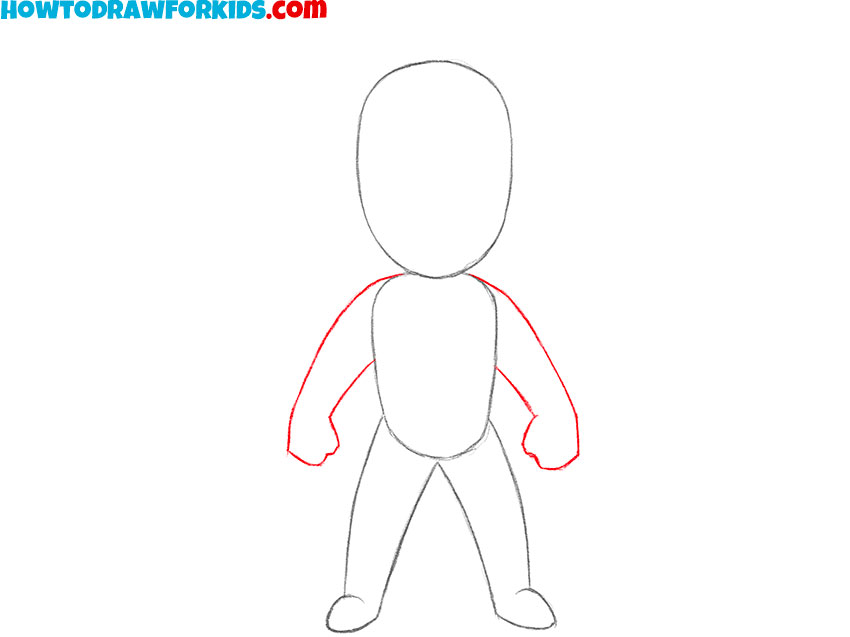
- Depict the mask and emblem.
Sketch the Spider-Man logo in the center of the chest and the large eyes of the mask in a very characteristic and recognizable shape.

- Mark the Spider-Man costume.
The insides of the torso and arms, as well as the tops of the legs, will be colored blue. Separate these areas of the superhero costume with smooth lines.
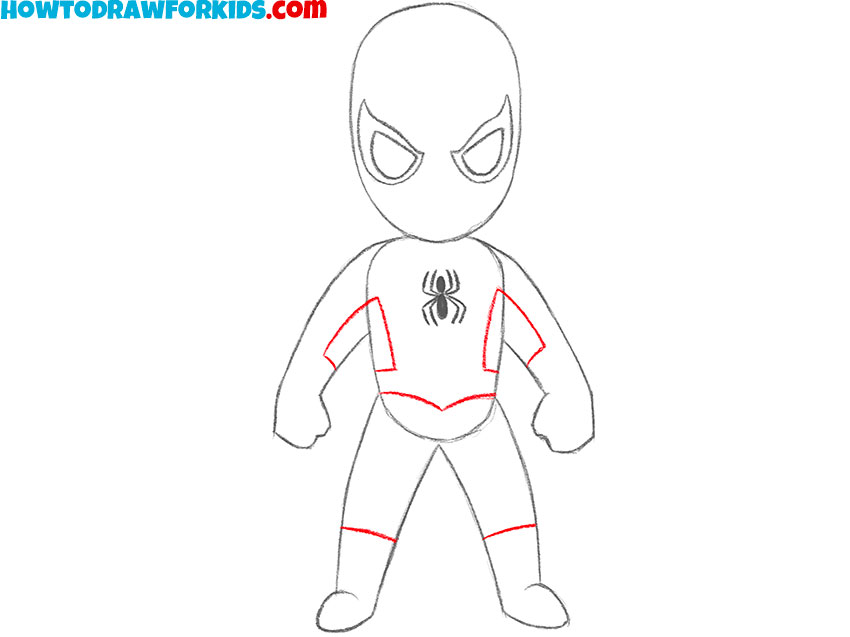
- Detail the clothes.
Draw longitudinal lines inside the outlines of the red part of the suit. Match the lines with the eyes and the spider logo in the center of the chest.
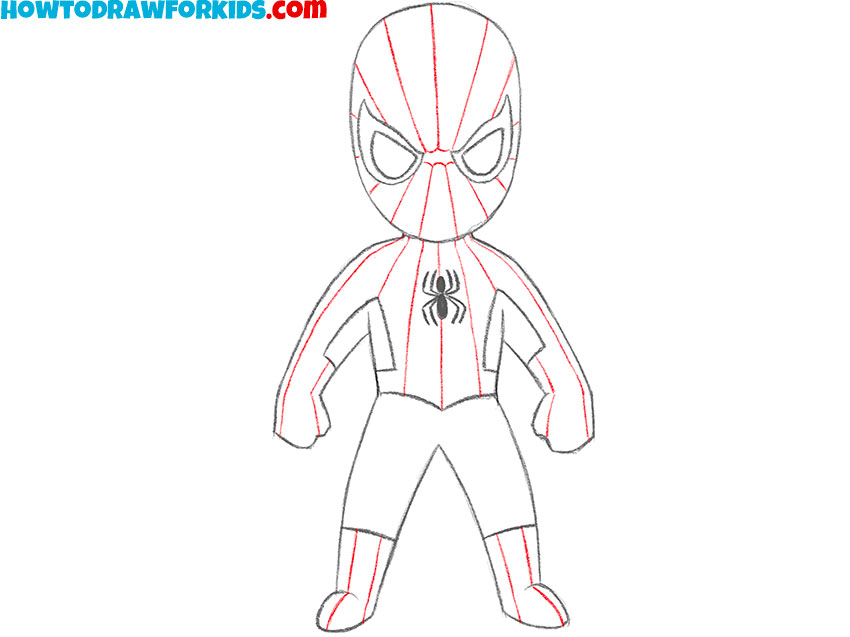
- Sketch out the web.
Finish the web pattern across the entire suit, paying attention to the flow and curvature around the arms and legs. Add the blue sections of the suit, following the traditional design.
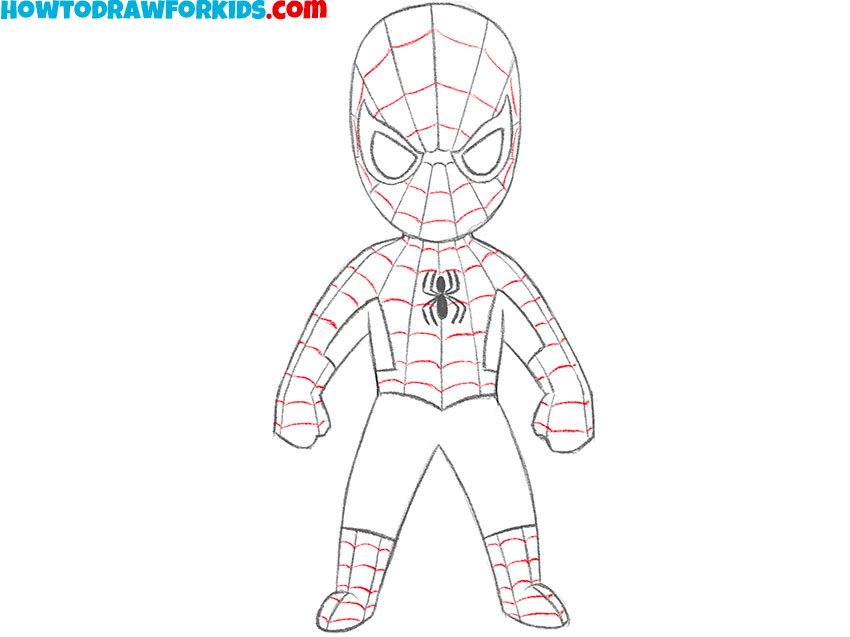
- Finalize the webbing and costume details.
With the webbing and color blocks in place, refine any last details of the suit. This could involve sharpening the edges of the blue sections or ensuring the web pattern is consistent throughout..
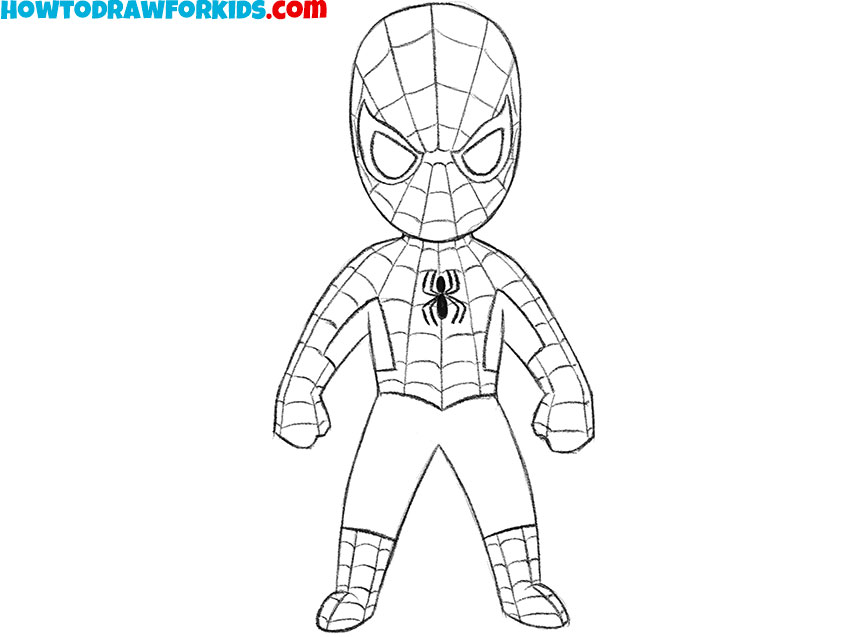
- Color Spider-Man.
Conclude the drawing by fully coloring in the red and blue sections of the suit. You can also add the shading to give depth to the muscles and folds in the fabric.
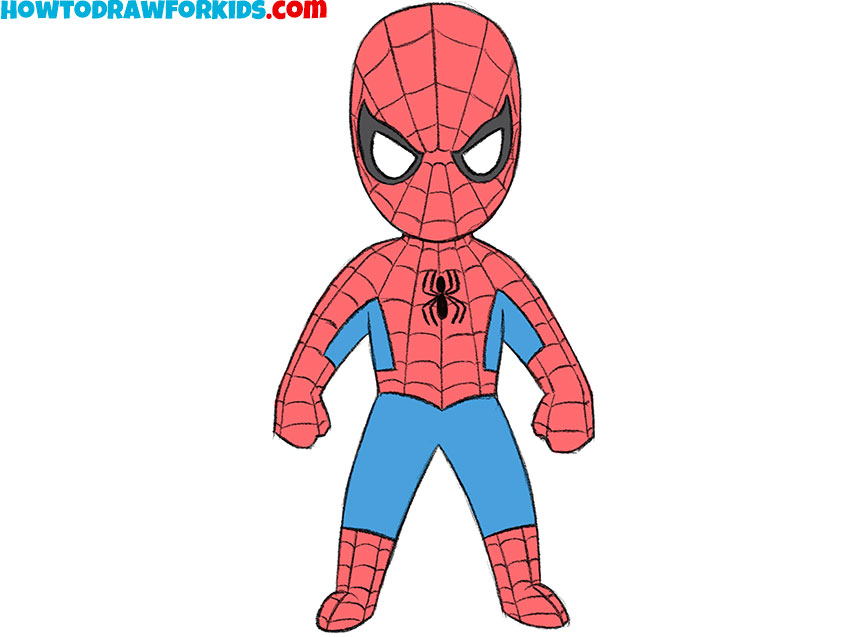
How to Draw Spider-Man: Video Tutorial
Additional Content
For those moments when you’re away from the screen but the urge to draw strikes, I’ve created a free PDF version of our Spider-Man lesson. It’s a compact guide that captures the essential steps, allowing you to enjoy drawing our chibi hero anytime, anywhere.
This PDF is crafted to slide easily into your daily life, ready to accompany you on all your travels. It’s perfect for keeping your drawing skills sharp, whether you’re nestled at your desk or swinging by the park. Just download, print, or keep it on your device for a convenient reference that doesn’t need a web to work.
Consider this PDF my gift to you, a token to encourage continuous creativity and the joy of drawing. With Spider-Man as your subject, you can now bring a piece of the superhero world into your hands, no matter where you find yourself. So, download this little guide and let the drawing adventure continue beyond the screen.
Alternative Drawing Techniques
In addition to the standard lesson, I’ve also crafted several alternative drawing techniques for Spider-Man to expand your practice and enhance your artistic skills. These variations introduce new challenges, like dynamic poses and intricate web patterns, designed to refine your technique and understanding of form.
Tackling these diverse methods, you’ll engage with Spider-Man’s character in different lights, from dramatic action shots to subtle, candid moments. Each approach offers unique insights, whether it’s mastering the texture of his suit or the agility captured in a mid-swing stance, all aimed at developing your artistic repertoire.
Adopting these alternative techniques will not only bolster your ability to draw Spider-Man but also invigorate your overall creative process. They are stepping stones toward greater artistic achievement, encouraging you to push boundaries and discover new depths to your drawing capabilities.
How to Draw Miniature Spider-Man
This method of drawing Spider-Man in chibi style starts with a focus on form and proportion. An oversized head paired with a diminutive body captures the essence of the chibi aesthetic. The large, circular head gives ample space for Spider-Man’s distinctive eyes, while the small body emphasizes his cartoonish charm.
The second step is all about infusing personality into our pint-sized hero. Careful attention is given to the eyes and facial expression, ensuring they convey the same bold spirit of Spider-Man in a more whimsical package. This stage is crucial for bringing out the character’s playful side, inviting artists to enjoy the creative process.
As we finalize our drawing, the addition of Spider-Man’s suit details and web patterns adds depth and authenticity. Yet in this chibi version, they’re simplified to maintain the overall cuteness. It’s here we blend the iconic with the adorable, culminating in a Spider-Man that’s ready for both action and awws.
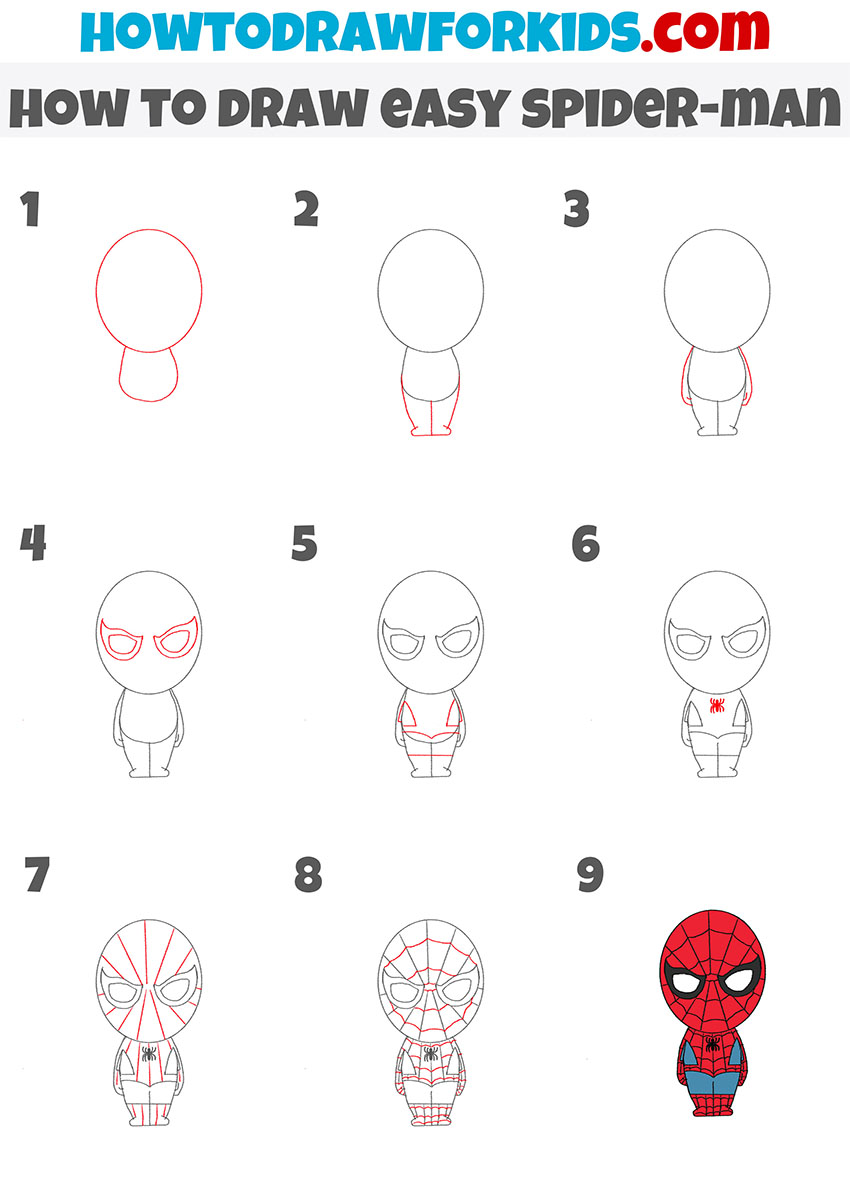
Extra Practice in Drawing Spider-Man: Changing Pose
In this drawing approach, we start with Spider-Man’s iconic stance, setting his legs apart wider than in the previous technique. This gives a sense of stability and readiness, capturing the essence of a superhero poised for action. The broadened stance also provides a solid foundation for his chibi form, emphasizing the power packed into his small frame.
Next, we focus on the proportional balance between the head and body, ensuring that even with a more dynamic pose, the charm of the chibi style is preserved. Adjusting the angle of the arms and legs to match the widened stance, we begin to see Spider-Man’s character take shape, ready to spring into web-slinging action.
Finally, we refine the details, from the web pattern of his suit to the contours of his body, ensuring they complement the adjusted stance. This method adds a touch of drama to the playful chibi Spider-Man, inviting the viewer to imagine him leaping off the page, swinging into his next adventure.

How to Draw Spider-Man in Motion
This drawing method captures Spider-Man in the midst of action, leaping through the air with his web slinging into action. The first steps focus on the dynamics of his pose, creating the illusion of movement and weightlessness. His extended limbs and angled body add to the feeling of him soaring across the cityscape.
The following stages involve sketching the web line that anchors Spider-Man to the buildings above. His hands are drawn with careful precision to depict the iconic web-shooting gesture. The details in his suit are simplified to keep the motion the main focus, while ensuring he’s immediately recognizable as the beloved web-slinger.
In the final phase, we solidify Spider-Man’s airborne adventure with the addition of detailed webbing and the finalization of his costume. The emphasis is on the flow of his suit and the curve of his web line, guiding the eye and emphasizing the direction of his swift movement. This is Spider-Man in full swing, as vibrant and dynamic on paper as he is in the comics.

Spider-Man in Ben Reilly’s Costume
Constant practice is vital in perfecting your rendition of Spider-Man. Each sketch hones your skills, bringing more life and fluidity to the character. Attempting his Ben Reilly suit adds complexity, demanding attention to the unique blue and red design, and challenging your coloring finesse.
Embrace the subtleties in shading and texture that this alternative costume offers. It’s an excellent exercise to refine your grasp on Spider-Man’s aesthetic, transforming your familiarity into expertise. As you practice, each stroke becomes more intuitive, contributing to your growth as an artist.
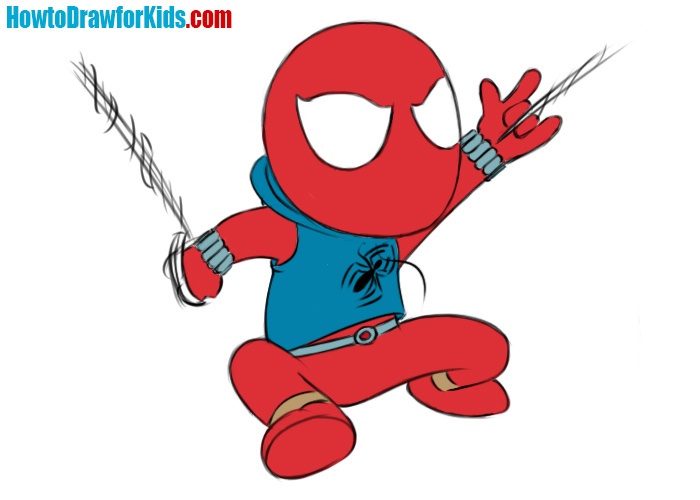
Spider-Man in Venom Costume
Let’s dive into drawing Spider-Man clad in the Venom suit, a stark turn from the classic red and blue to the symbiote’s enveloping black. This version isn’t just about a color change; it’s about capturing the darker essence that this suit embodies.
Recall that the symbiote was Spider-Man’s black costume, a living entity with its own character.The stark white of the eyes and emblem will be your guiding contrast, essential for capturing the powerful presence of Venom.
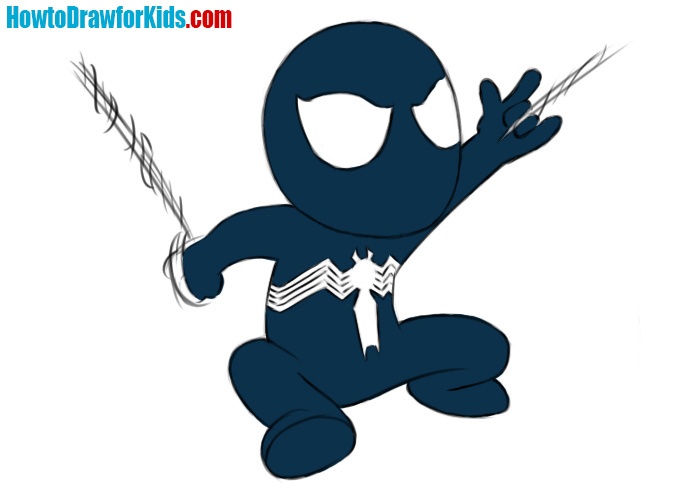
Spider-Man Hanging Head Down on the Web
Now that you’ve got the hang of the foundational Spider-Man sketches, let’s elevate your skills with a more dynamic pose: our hero hanging headfirst in his web-slinging glory. This perspective requires a keen eye for detail, as you’ll need to invert the usual proportions and consider how gravity affects his suit and body.
As you draw Spider-Man in this iconic upside-down position, focus on the curve of his spine, the natural drape of his costume, and the relaxed yet ready position of his hands. It’s a playful twist that adds depth to your artistic interpretation, challenging you to depict Spider-Man’s world from a whole new angle.
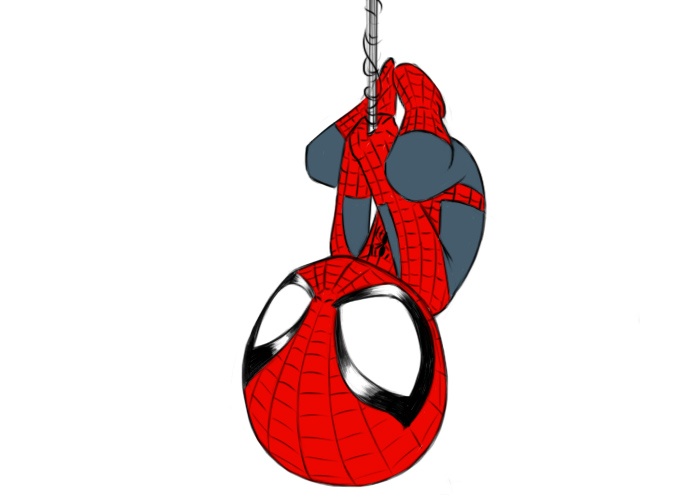
Conclusion
Just as Spider-Man swings from building to building, saving the world one adventure at a time, I strive to guide you through the world of drawing, one sketch at a time. As Spidey weaves his webs to safeguard the city, visit my site for more adventures, like drawing the charming figures of My Little Pony or the grand killer whales of the deep sea.
Connect with me on social media to catch the latest on drawing tutorials and tips, becoming part of a community where every stroke is a step toward mastery. Share your desires for new lessons or characters in the comments; your input is the cornerstone of our collective artistic journey, shaping the path we draw together.





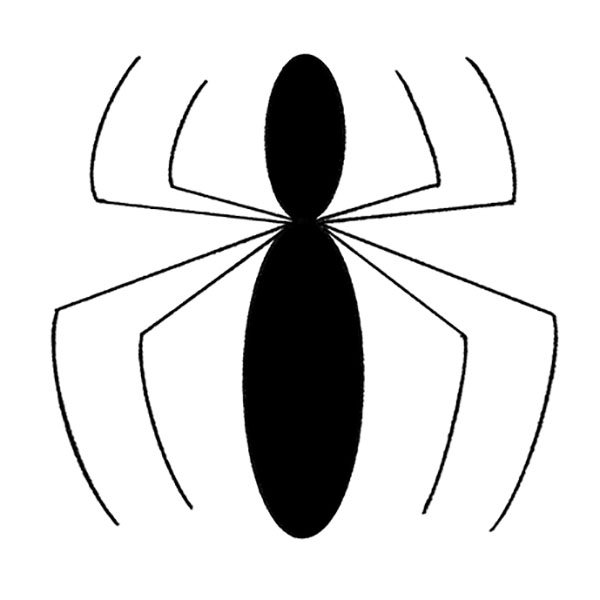

I drew it